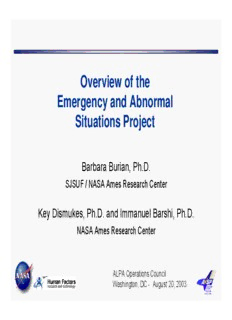
Overview of the Emergency and Abnormal Situations Project PDF
Preview Overview of the Emergency and Abnormal Situations Project
Overview of the Emergency and Abnormal Situations Project Barbara Burian, Ph.D. SJSUF / NASA Ames Research Center Key Dismukes, Ph.D. and Immanuel Barshi, Ph.D. NASA Ames Research Center ALPA Operations Council Washington, DC - August 20, 2003 The Challenge Emergency and abnormal situations: - are often time critical, complex, and/or ambiguous - are high stress, high workload, and a great deal is at stake - require exceptionally high levels of coordination inside and outside of the airplane Emergency and abnormal procedures: - are generally focused on aircraft systems rather than on the situation as a whole - are practiced seldom (twice a year or less) and used rarely - are often highly dependent on fragile cognitive processes - when needed, are crucial and must be performed correctly Industry Contacts and Consultants Manufacturers: Boeing, Airbus Industries, BAE Systems Regulatory Agencies: FAA, CAA (UK), ICAO Unions and Trade ALPA, APA, SWAPA, ATA Groups: Accident Investigation NTSB, TSB of Canada Bodies: Airlines: Southwest Airlines, United Airlines, Continental Airlines, American Airlines, Fed Ex, Aloha Airlines, Hawaiian Airlines, Air Canada, Cathay Pacific, Airborne Express, UPS, US Airways, TWA (prior to merger) Emergency and Abnormal Situations Project Taxonomy of the Domain 15 Different Categories of Issues: Broad, Over-arching Issues (3) Issues Related to Checklists and Procedures (3) Issues Related to Humans (5) Issues Related to the Aircraft (2) Issues Related to Training (1) Selected Emergency Equipment and Evacuation Issues (1) Emergency and Abnormal Situations Project Taxonomy of the Domain Broad, Over-arching Issues Economic and Definitions & Philosophies Regulatory Perspectives Pressures Philosophy of Response to Emergencies Evident in Checklist Design MD-11 In-flight Fire Nova Scotia, Canada September 2, 1998 If smoke/fumes are not eliminated, land at nearest suitable airport Philosophy of Response to Emergencies – Checklist Design In a study of 15 in-flight fires that occurred between January 1967 and September 1998, the TSB of Canada determined that the average amount of time between the detection of an on-board fire and when the aircraft ditched, conducted a forced landing, or crashed was 17 minutes. Response to Emergencies: Job Responsibilities Influence Perspectives and Behavior
Description: